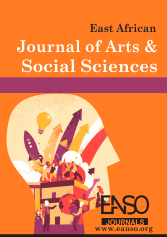Embracing Diversity: A Novel Approach to Deconstructing Gender Stereotyped Traits through Gender Atypical Kiswahili Children's Storybooks
Abstract
This paper explores the potential of using gender atypical Kiswahili children's storybooks as a powerful tool to deconstruct traditional, ingrained gender stereotyped traits among children. In recent years, there has been a growing concern about the negative impact of gender stereotyped traits on children's development and self-perception. Traditional societal gender schemata often reinforce stereotypical traits for boys and girls from an early age, limiting their understanding of the diverse range of personalities, qualities, and characteristics that individuals can possess. Therefore, this paper adopts a novel approach that utilises gender atypical Kiswahili storybooks to challenge and reshape these preconceived notions about gender traits. The study explores how children construct gender traits when exposed to gender atypical Kiswahili children’s storybooks. Bandura’s social learning theory formed the theoretical framework on which the study was underpinned. Data was generated using drawings with grade three children from a purposively selected school in Trans-Nzoia County, Kenya. The findings of this study revealed that when children were exposed to gender-atypical Kiswahili children’s stories, more girls compared to boys changed from constructing gender stereotyped traits to gender-atypical traits. The findings also revealed that even though some participants conformed to gender stereotyped traits, there was a change in their perspectives to adopt gender-atypical traits. This paper, therefore, suggests that exposure of children to gender-atypical Kiswahili children’s stories could deconstruct gender stereotyped traits during their early stages of socialisation. The paper recommends that Ministries of Education, Curriculum Development, and book publishers should develop guidelines and a policy framework to promote the authorship and publication of gender atypical Kiswahili children’s storybooks to enable children to construct gender traits in a neutral and non-sexist manner. This will enable children to question and redefine their understanding of gender, thus fostering a more diverse, inclusive, and open-minded generation.
Downloads
References
Abad, C., & Pruden, S. M. (2013). Do storybooks really break children's gender stereotypes?
Aina, O. E., & Cameron, P. A. (2011). Why does gender matter? Counteracting stereotypes with young children. Dimensions of Early Childhood, 39(3).
Anderson, D. A., & Hamilton, M. (2005). Gender role stereotyping of parents in children’s picture books: The invisible father. Sex Roles, 52(3–4), 145–151.
Archer, J. (2022). Childhood gender roles: Social context and organisation. In Childhood social development (pp. 31-61). Psychology Press.
Bandura, A., Ross, D., & Ross, S. A. (1961). Transmission of aggression through imitation of aggressive models. The Journal of Abnormal and Social Psychology, 63(3), 575.
Bandura, A. (1986). Social foundations of thought and action: A social cognitive theory. Englewood Cliffs, NJ, US: Prentice-Hall, Inc.
Bandura, A., Adams, N. E., & Beyer, J. (1977). Cognitive processes mediating behavioral change. Journal of personality and social psychology, 35(3), 125.
Bem, S. L. (1981). Gender schema theory: A cognitive account of sex typing. Psychological Review, 88(4), 354.
Bender, D. L., & Leone, B. (1989). Human sexuality: 1989 annual. San Diego, CA: Greenhaven.
Bertrand, M. (2020). Gender in the twenty-first century. In AEA Papers and Proceedings (Vol. 110, pp. 1-24). 2014 Broadway, Suite 305, Nashville, TN 37203: American Economic Association.
Bevik, C., & Liljegren, K. (2010). Könsstereotyper i barnböcker och deras inverkan på framtida yrkesval hos förskoleflickor. Lunds Universitet institutionen för psykologi Kandidatuppsats VT.
Blakemore, J. E. O., & Centers, R. E. (2005). Characteristics of boys’ and girls’ toys. Sex Roles, 53(9–10), 619–633.
Bonus, J. A., Lynch, T., Nathanson, A., & Watts, J. (2022). Counter-stereotypical, yet counterproductive? How families at a science museum respond to narratives that defy gender stereotypes. Media Psychology, 25(3), 469-498.
Brown, A., et al. (2021). Beyond Pink and Blue: Exploring Gender Diversity in Children's Literature. Educational Psychology Review.
Cherney, I. D., Harper, H. J., & Winter, J.A. (2006). New toys for tots: What preschoolers identify as “boy and girl toys. jouets de filles » Enfance, 3, 266-282
Chick, K. A., Heilman-Houser, R. A., & Hunter, M. W. (2002). The impact of child care on gender role development and gender stereotypes. Early Childhood Education Journal, 29(3), 149-154.
Chung, Y., & Huang, H. H. (2021). Cognitive-based interventions break gender stereotypes in kindergarten children. International Journal of Environmental Research and Public Health, 18(24), 13052.
Clarke, A. K., & Stermac, L. (2011). The influence of stereotypical beliefs, participant gender, and survivor weight on sexual assault response. Journal of Interpersonal Violence, 26(11), 2285–2302.
Connell, R.W. (1995). Masculinities. Los Angeles, CA: University of California Press
Eagly, A. H., & Mladinic, A. (1989). Gender stereotypes and attitudes toward women and men. Personality and social psychology bulletin, 15(4), 543-558.
Eccles, J. S., & Wigfield, A. (1995). In the mind of the actor: The structure of adolescents' achievement task values and expectancy-related beliefs. Personality and social psychology bulletin, 21(3), 215-225.
Eccles, J. S. (1999). The development of children ages 6 to 14. The future of children, 30-44.
Eisenberg, N., Martin, C. L., & Fabes, R. A. (1996). Gender development and gender effects. Handbook of educational psychology, 358-396.
Ekiru, S. (2023). Ukiushi wa Taswira Dumifu za Uana katika Hadithi za Kiswahili za Watoto. Master’s Thesis. Moi University.
Ekiru, S. E. (2019). Exploring the use of Gender-Atypical Kiswahili children’s stories to address Gender Stereotyping among Learners in a selected primary School in Trans-Nzoia County, Kenya. Master’s dissertation. Moi University.
Evans, L., & Davies, K. (2000). No sissy boys here: A content analysis of the representation of masculinity in elementary school reading textbooks. Sex Roles, 42(3–4), 255–270.
Ezenwa-Ohaeto, E. (2015). Fighting Patriarchy in Nigerian Cultures through Children’s Literature. Studies in Literature and Language, 10(6), 59–66.
Floyd, C. A. (2012). Gender Depiction in Preschool Books: A Comparison between Early Care and Education Classrooms in the United States and Norway. Electronic Theses and Dissertations. 203. Available at https://digitalcommons.du.edu/etd/203
Fowler, B. (1999). Pierre Bourdieu-La domination masculine. Contemporary sociology, 28, 478-481.
Fox, M. (1993). Men Who Weep, Boys Who Dance: The Gender Agenda between the Lines in Children’s Literature in Language Arts pp. 84-88.
Freeman, N. K. (2007). Preschoolers’ perceptions of gender appropriate toys and their parents’ beliefs about genderized behaviors: Miscommunication, mixed messages, or hidden truths? Early Childhood Education Journal, 34(5), 357–366.
Garcia, M., & Lee, S. (2020). Empowering Young Minds: The Role of Gender-Atypical Storybooks in Promoting Inclusivity. Early Childhood Education Journal.
Gooden, A. M., & Gooden, M. A. (2001). Gender representation in notable children’s picture books: 1995–1999. Sex Roles, 45(1–2), 89–101.
Gunderson, E. A., Ramirez, G., Levine, S. C., & Beilock, S. L. (2012). The role of parents and teachers in the development of gender-related math attitudes. Sex Roles, 66(3–4), 153–166.
Gunderson, E. A., Ramirez, G., Levine, S. C., & Beilock, S. L. (2012). The role of parents and teachers in the development of gender-related math attitudes. Sex Roles, 66, 153-166.
Hagerman, R.J., Greco, C. M., Tassone, F., Chudley, A. E., Del Bigio, M. R., Jacquemont, S., ... & Hagerman, P. J. (2002). Neuronal intranuclear inclusions in a new cerebellar tremor/ataxia syndrome among fragile X carriers. Brain, 125(8), 1760-1771.
Hagerman, R. J., Miller, L. J., McGrath‐Clarke, J., Riley, K., Goldson, E., Harris, S. W., … Ognibene, T. C. (2002). Influence of stimulants on electrodermal studies in fragile X syndrome. Microscopy Research and Technique, 57(3), 168–173.
Howansky, K., Wilton, L. S., Young, D. M., Abrams, S., & Clapham, R. (2021). (Trans) gender stereotypes and the self: Content and consequences of gender identity stereotypes. Self and Identity, 20(4), 478-495.
Islam, K. (2003). Sungura Mjanja. Nairobi: Oxford University Press.
Karan, W. (2005). Zawadi ya Rangi. Nairobi: Phoenix Publishers.
Kneeskern, E. E., & Reeder, P. A. (2022). Examining the impact of fiction literature on children’s gender stereotypes. Current Psychology, 41(3), 1472-1485.
Koenig, A. M., Eagly, A. H., Mitchell, A. A., & Ristikari, T. (2011). Are leader stereotypes masculine? A meta-analysis of three research paradigms. Psychological Bulletin, 137(4), 616.
Kohlberg, L. (1966). Moral education in the schools: A developmental view. The School Review, 74(1), 1-30.
Kortenhaus, C. M., & Demarest, J. (1993). Gender role stereotyping in children's literature: An update. Sex Roles, 28, 219-232.
Lamb, M. E. (2010). The development and significance of father-child relationships in two-parent families. The role of the father in child development/John Wiley & Sons.
Leaper, C. (2000). Gender, affiliation, assertion, and the interactive context of parent–child play. Developmental psychology, 36(3), 381.
Lewela, M. (2008). Kombo Arudi Shule. Nairobi: East Africa Educational Publishers.
Lewis, M., Cooper Borkenhagen, M., Converse, E., Lupyan, G., & Seidenberg, M. S. (2022). What might books be teaching young children about gender? Psychological Science, 33(1), 33-47.
Liu, F. (2006). Boys as only‐children and girls as only‐children—parental gendered expectations of the only‐child in the nuclear Chinese family in present‐day China. Gender and Education, 18(5), 491–505.
Liwag, M. J. D., Ramirez, D. M., & Santiago, G. S. (2022). Challenging Gender Stereotypes through the Selection of Gender-Neutral Texts in the Philippine School Context. International Journal of Academic Multidisciplinary Research (IJAMR) 6 (6) 275-286.
Lundgren, B., & Khau, M. (2015). Broken promises novel's impact on shaping youth identity. Reading & Writing-Journal of the Reading Association of South Africa, 6(1), 1-8.
Master, A. (2021). Gender stereotypes influence children’s STEM motivation. Child Development Perspectives, 15(3), 203-210.
Mbuthia, D. E. M. (2018). The Role of Kiswahili Children’s Literature in Formulating Their World View. International Journal of Educational Research. Vol. 6 (2)129-140
McCabe, J., Fairchild, E., Grauerholz, L., Pescosolido, B. A., & Tope, D. (2011). Gender in twentieth-century children’s books: Patterns of disparity in titles and central characters. Gender & society, 25(2), 197-226.
McLeod, S. A. (2016). Bandura-social learning theory. Retrieved From. http://www.simply psychology.org/bandura.html.
Mirele, M. (2015). 20 Children's Books That Redefine Gender Roles. https://www.goodnet.org/ articles/20-childrens-books-that-redefine-gender-roles
Mitchell, C., De Lange, N., & Moletsane, R. (2017). Participatory Visual Methodologies: Social Change, Community and Policy. SAGE Publications Ltd.
Mitchell, C., Theron, L., Stuart, J., Smith, A., & Campbell, Z. (2011). Drawings as a research method. In Picturing research (pp. 19-36). Sense Publishers.
Mogambi, H. (2006). Vitendo vya Jamila. Nairobi. Moran Publishers.
Morrow, V. (2006). Understanding gender differences in context: implications for young children's everyday lives. Children & society, 20(2), 92-104.
Mpesha, N. (2007). African children's literature: a bibliography. https://www.amazon.com/ African-Childrens-Literature-Nyambura-Mpesha/dp/1425914713
Mpesha, N. G. A. (1996). Children’s literature in Tanzania: A literary appreciation of its growth and development. Kenyatta University retrieved from http://ir-library.ku.ac.ke/handle/ 123456789/13816
Mutuku, Y. (2014). Mama Mwizi. Nairobi: Moran Publishers.
Mutunda, S.N. (2009). Through a Female Lens: Aspects of Masculinity in Francophone African Women’s Writing. D. Phil Thesis. Tucson: The University of Arizona.
Mwangi, W. (2009). Atoke Asitoke? Nairobi: Oxford University Press.
Nhundu, T. J. (2007). Mitigating gender-typed occupational preferences of Zimbabwean primary school children: The use of biographical sketches and portrayals of female role models. Sex Roles, 56(9–10), 639–649.
Nyakeri, F. (2006). Siku za Juma 1a. Nairobi: Oxford University Press.
O'Brien, M., & Huston, A. C. (1985). Development of sex-typed play behavior in toddlers. Developmental Psychology, 21(5), 866.
O'Brien, M., Huston, A. C., & Risley, T. R. (1983). Sex-typed play of toddlers in a day care center. Journal of Applied Developmental Psychology, 4(1), 1–9.
Oskamp, S., Kaufman, K., & Wolterbeek, L. A. (1996). Gender role portrayals in preschool picture books. Journal of Social Behavior and Personality, 11(5), 27.
Prasetia, I., Lisnasari, S. F., Gajah, N., Sekali, P. B. K., & Rahman, A. A. (2022). Influence of early childhood programs' literacy movement on students’ interest and reading ability. Jurnal Obsesi: Jurnal Pendidikan Anak Usia Dini, 6(6), 7173-7185.
Pruden, S. M., & Abad, C. (2013). Do storybooks really break children’s gender stereotypes? Frontiers in Psychology, 4, 986.
Richardson, J. T. (1993). Gender differences in responses to the Approaches to Studying Inventory. Studies in Higher Education, 18(1), 3–13.
Santiago, g. S., Santos, J. M. B., Ramirez, D. M., & Liwag, M. J. D. (2023). Challenging Gender stereotypes: Selecting Gender-Neutral texts in Literature Class to Redefine Gender Roles among Early Childhood Education Pupils. Languages of politics, 119.
Senawati, J., Suwastini, N. K. A., Jayantini, I. G. A. S. R., Adnyani, N. L. P. S., & Artini, N. N. (2021). The benefits of reading aloud for children: A review in the EFL context. IJEE (Indonesian Journal of English Education), 1(1), 80-107.
Smith, J., & Johnson, L. (2022). Breaking Boundaries: The Impact of Gender-Atypical Storybooks on Children's Perceptions. Journal of Child Development.
Stockard, J., & McGee, J. (1990). Children's occupational preferences: The influence of sex and perceptions of occupational characteristics. Journal of Vocational Behavior, 36(3), 287-303.
Thorne, B. (1993). Gender play: Girls and boys in school. Rutgers University Press.
Toçi, A., & Aliu, M. (2013). Gender stereotypes in current children’s English books used in elementary schools in the Republic of Macedonia. American International Journal of Contemporary Research, 3(12), 32–38.
Walibora, K. (2013). Furaha ya Arope. Nairobi: Oxford University Press.
Weitzman, L. J., Eifler, D., Hokada, E., & Ross, C. (1972). Sex-role socialization in picture books for preschool children. American Journal of Sociology, 77(6), 1125–1150.
Worland, J. (2008). Girls will be girls... and so on. Children & Libraries, 6(1), 42.
Zawadi, R. (2013). Tuzo ya Baba. Nairobi: Queenex Publisher Limited.
Copyright (c) 2025 Simon Esekon Ekiru

This work is licensed under a Creative Commons Attribution 4.0 International License.




























